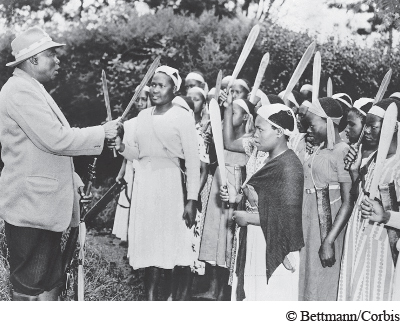Wanjiku of Kenya

B orn in 1910 among the Gikuyu people of East Africa, Wanjiku witnessed almost the entire twentieth century.23 Her life encompassed the dramatic intrusion of British colonialism, the coming of Christianity, the Mau Mau rebellion against European rule, the achievement of independence for Kenya in 1963, and the challenges of modernization in the decades that followed.
And yet, the first thirty years or more of Wanjiku’s life were shaped far more by the customary patterns of rural Gikuyu culture than by the transformations of colonial rule. She grew up in her father’s compound, where her mother, three other wives, and more than a dozen children also lived. As a child, she began contributing to the household — fetching water, firewood, and vegetables — even as she learned the stories, riddles, and proverbs of Gikuyu folklore. At age fourteen, she had her ears pierced, thus achieving a “new stage of maturity.”
Far more important, however, was her “circumcision,” a procedure that involved the cutting of her genitals and the excision of the clitoris. For Wanjiku, as for virtually all Gikuyu girls, this procedure was a prerequisite for becoming “a grown-
Now Wanjiku was also able to attend the evening dances where young men and women mingled. There she met her first husband, Wamai, who initiated the long process of negotiation between families and the payment of numerous goats and cows to the bride’s father. She said of her marriage, “[It] was a big change — learning about sex and my husband’s habits.” Tragedy struck, however, when both her husband and her first child died. A few years later, Wanjiku married Kamau, the younger brother of her first husband, with whom she had three sons. Her second marriage, unlike the first, was accompanied by a church service and a wedding ring, signs of encroaching Western culture. Both marriages were apparently relatively satisfying, and she reported with pride that neither man mistreated or beat her.
During the 1940s and 1950s, the new realities of colonial life began to touch Wanjiku more personally than before. She and Kamau became Christians around 1940, and in 1948 Wanjiku “became saved.” “The saved ones,” she declared, “do not take tobacco nor drink. And they don’t abuse anybody.” She then joined a church-
In 1952, Wanjiku found herself caught up in the Gikuyu-
The British crushed the Mau Mau rebellion by 1956, but by 1963 Kenya, like dozens of other African countries, had achieved its independence. Wanjiku remembered the day with exhilaration. “We spent the whole night singing and dancing. We were so happy because we would never be ruled by foreigners again. It also meant the end of the beatings.” It was perhaps the high point of Wanjiku’s consciousness as a public person and a participant in a new nation.
In the decades following independence, Wanjiku experienced still further changes. She and her husband began to grow tea as a cash crop, an undertaking that had been limited to European farmers for much of the colonial era. Kenya’s new government tried to forbid female circumcision, and, as young people were increasingly drawn to the larger cities, older rural social patterns broke down. Boys and girls of different age-
By the 1990s, Wanjiku was an old woman afflicted with arthritis and much-
Question: How does Wanjiku’s life reflect both the continuities and changes of the twentieth century in African history?